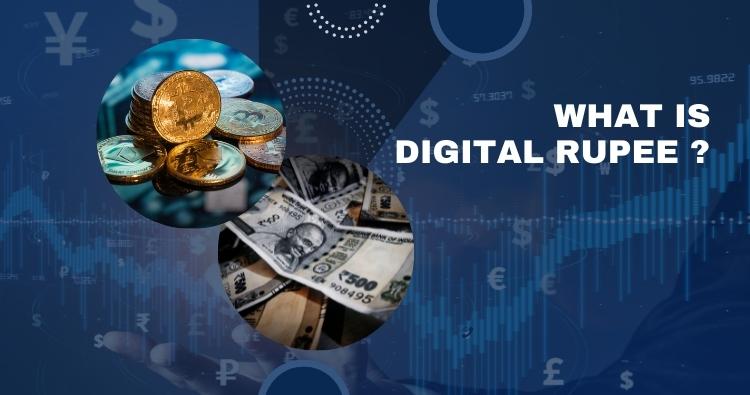- +91 8097492827
-



What Is Digital Rupee?
The demand for private cryptocurrency has witnessed tremendous demand in the last few years. Many illegal activities and money laundering have taken place through private cryptocurrency transactions. And the government of India sees the mushrooming of these private cryptocurrencies as a threat to the formal financial system.
To tackle these issues and more, the Indian government has clearly mentioned that cryptocurrencies will never be legal tender. In this year's budget, the finance minister announced RBI would launch a digital rupee that will work on blockchain and act as a legal tender.
This article will talk about the digital rupee and how it differs from other cryptocurrencies.
Countries around the world are planning to launch their cryptocurrency. The cryptocurrency that a country's central bank launches is the Central Bank Digital Currency or CBDC.
The digital rupee, when introduced, would be India’s CBDC.
Digital rupee, as the word sounds, will be the digital version of the rupee. Currently, the Indian currency is available as paper notes and coins. After introducing the digital rupee, the digital rupee will be another form of Indian currency. So, people can exchange a paper note of Rs.100 for Rs.100 for the digital rupee.
The Reserve Bank of India will issue the digital rupee, and the central bank will decide on the supply of the digital rupee just like it does for regular paper currency.
Benefits of Digital Rupee
The government and experts believe that the digital rupee will bring about a change in payments and make digital transactions faster and safer.
Move towards a cashless economy: Compared to other developed countries, cash is widely prevalent in India. There is a cost associated with paper currency, such as printing, storing and transportation. It is estimated that the cost of a paper note is 17% of the value of the paper note. Moreover, the paper notes don't last forever, and new paper notes have to replace soiled paper notes.
The introduction of the digital rupee may reduce our dependence on paper notes. The government may end up saving money in this way.
The introduction of the digital rupee may be the first step towards an ultimately cash-free India.
Prevent money laundering and illegal activities
Many money laundering and illicit activities are currently taking place through cash and private cryptocurrencies. The anonymity of cash and private cryptos lets people continue with the dealings without getting caught. But, as the digital rupee will be in the digital format, the government may be able to track each rupee. The wide adoption of the digital rupee may make it harder for people to carry out money laundering and other illegal activities.
Difference between the digital rupee and digital transactions
One of the key differences between the digital rupee and digital transactions like UPI and net banking is the underlying technology. CBDCs use distributed ledger technology (DLT), often combined with traditional central bank and payment infrastructure in a hybrid architecture.
Moreover, an intermediary, such as a bank or a platform like Google Pay, is needed to carry out digital transactions. However, in the case of the digital rupee, the RBI can directly issue a digital rupee through a new platform without the help of a bank or another company.
UPI payments are now made with the digital equivalents of current cash notes. This means that every rupee sent via UPI is backed by paper currency.
Difference between the digital rupee and private cryptocurrency
The digital rupee or any other central bank digital currency (CBDC) isn’t a cryptocurrency in the truest sense.
A CBDC will be created and stored in a more centralised manner than other cryptocurrencies, which are stored on a decentralised blockchain network.
This means that the digital rupee can be monitored and regulated, unlike a private cryptocurrency. Your personal information will be 'linked' to your CBDC and may be subject to examination and regulation by the authorities.
Conclusion
While the RBI may come out with the digital rupee in the financial year 2022-23, it may go through a series of trials before the citizens at large can actually access the digital rupee.
It would be interesting to follow the developments of the digital rupee.
This blog is purely for educational purposes and not to be treated as personal advice. Mutual fund investments are subject to market risks, read all scheme-related documents carefully.
B-709, 7th Floor, Rajshivam
Chs Ltd, Shiv Vallabh Road,
Ashokvan, Dahisar - East,
Mumbai - 400068.
Disclaimer | Commission Disclosure | Privacy Policy | Terms & Conditions | SID/SAI/KIM | Code of Conduct | Important Links | SEBI Circulars | AMFI Risk Factors
Grace Finserv © 2024
Risk Factors – Investments in Mutual Funds are subject to Market Risks. Read all scheme-related documents carefully before investing. Mutual Fund Schemes do not assure or guarantee any returns. Past performances of any Mutual Fund Scheme may or may not be sustained in the future. There is no guarantee that the investment objective of any suggested scheme shall be achieved. All existing and prospective investors are advised to check and evaluate the Exit loads and other cost structures (TER) applicable at the time of making the investment before finalizing any investment decision for Mutual Funds schemes. We deal in Regular Plans only for Mutual Fund Schemes and earn a Trailing Commission on client investments. Disclosure of commission earnings is made to clients at the time of investments.
AMFI Registered Mutual Fund Distributor – ARN-295048 | Date of initial registration – 28-Jan-2024 | Current validity of ARN – 27-Jan-2027